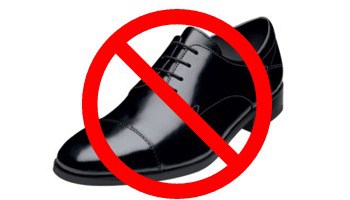A Day Without Shoes
Why did the Torah specifically forbid leather shoes on Yom Kippur (rather than ban sitting in a comfortable chair, for example)?
For a deeper insight into the meaning of this prohibition, we must examine what shoes symbolize in the Torah. The first place they are mentioned in the Torah is at the beginning of Moses’ prophecy:
Moses was shepherding the sheep… and he came to the mountain of G-d, Horeb. [The name of the mountain was Horeb.] An angel of G-d appeared to him in a flame from a bush, and behold, the bush was burning with fire but was not consumed… G-d called to him and said, “Moses, Moses,” and he answered, “Here I am.” G-d said, “Do not come any closer, take your shoes off your feet because the place where you are standing is holy ground.”
Similarly, when Joshua is confronted by an angel, he is told to take off his shoe. Jewish law forbids wearing shoes in the Temple in Jerusalem. A mourner may also not wear leather shoes during the first and most intense period of mourning. What do these instances have in common?
Some commentaries suggest that the shoe is a metaphor for the human body and physicality. Just as the shoe encloses that part of the body which comes in contact with the earth and enables it to walk in and interact with the world, so too the body encases the component of the soul which interfaces this world and allows it to interact with finite physicality. As our bodies are covered by our skin, so too, shoes are made of animal skin, leather. When G-d wants us to ignore our physical elements and try to relate to Him only on a spiritual level, He commands us to remove our shoes. This is the reason that both Moses and Joshua were told to remove their shoes during prophecy, while on holy ground. This was an experience of the soul, not the body. One does not visit the Temple to enhance his physical well being but rather to connect to the spiritual dimension. The mourner may take comfort from knowing that although a beloved person is gone from this world, nevertheless, his or her soul still exists, albeit without its “shoe,” the body.
So too on Yom Kippur, when we focus entirely on the soul and ignore the body completely, it is appropriate that we avoid wearing that which most symbolizes the body — the leather shoe.
Sources:
Exodus 3:1-5.
Joshua 5:13-15.
Babylonian Talmud, Berachot 62b.
Ezekiel 26:23.
Maharal of Prague, Netivot Olam, Netiv Ha’Avodah, ch. 6; Chidushei Aggadot, Sanhedrin 49a.
Rabbi Chaim of Volozhin, Ruach Chaim on Pirkei Avot, ch. 1, Mishnah 1.

